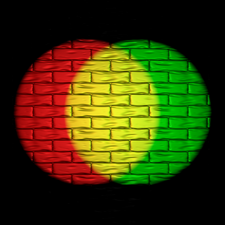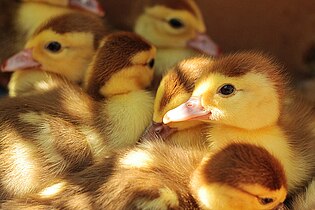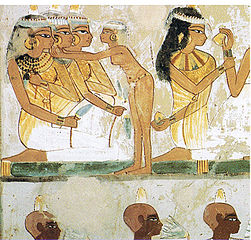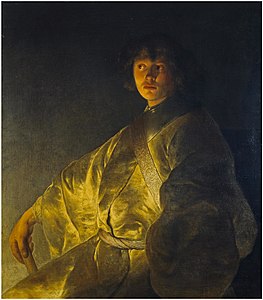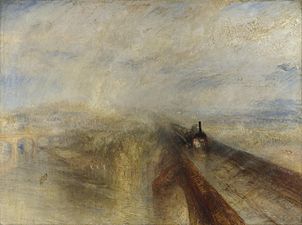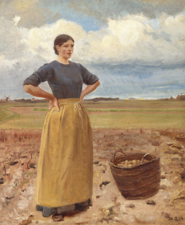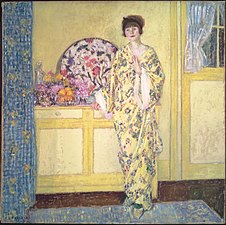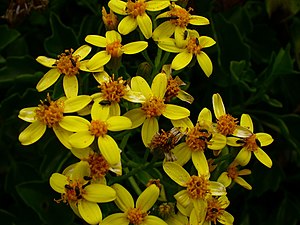
A | B | C | D | E | F | G | H | CH | I | J | K | L | M | N | O | P | Q | R | S | T | U | V | W | X | Y | Z | 0 | 1 | 2 | 3 | 4 | 5 | 6 | 7 | 8 | 9
| Yellow | |
|---|---|
| Spectral coordinates | |
| Wavelength | 575–585[1] nm |
| Frequency | 521–512 THz |
| Hex triplet | #FFFF00 |
| sRGBB (r, g, b) | (255, 255, 0) |
| HSV (h, s, v) | (60°, 100%, 100%) |
| CIELChuv (L, C, h) | (97, 107, 86°) |
| Source | HTML/CSS[2] |
| B: Normalized to (byte) H: Normalized to (hundred) | |
Yellow is the color between green and orange on the spectrum of light. It is evoked by light with a dominant wavelength of roughly 575–585 nm. It is a primary color in subtractive color systems, used in painting or color printing. In the RGB color model, used to create colors on television and computer screens, yellow is a secondary color made by combining red and green at equal intensity. Carotenoids give the characteristic yellow color to autumn leaves, corn, canaries, daffodils, and lemons, as well as egg yolks, buttercups, and bananas. They absorb light energy and protect plants from photo damage in some cases.[3] Sunlight has a slight yellowish hue when the Sun is near the horizon, due to atmospheric scattering of shorter wavelengths (green, blue, and violet).
Because it was widely available, yellow ochre pigment was one of the first colors used in art; the Lascaux cave in France has a painting of a yellow horse 17,000 years old. Ochre and orpiment pigments were used to represent gold and skin color in Egyptian tombs, then in the murals in Roman villas.[4] In the early Christian church, yellow was the color associated with the Pope and the golden keys of the Kingdom, but it was also associated with Judas Iscariot and used to mark heretics. In the 20th century, Jews in Nazi-occupied Europe were forced to wear a yellow star. In China, bright yellow was the color of the Middle Kingdom, and could be worn only by the emperor and his household; special guests were welcomed on a yellow carpet.[5]
According to surveys in Europe, Canada, the United States and elsewhere, yellow is the color people most often associate with amusement, gentleness, humor, happiness, and spontaneity; however it can also be associated with duplicity, envy, jealousy, greed, justice, and, in the U.S., cowardice.[6] In Iran it has connotations of pallor/sickness,[7] but also wisdom and connection.[8] In China and many Asian countries, it is seen as the color of happiness, glory, harmony and wisdom.[9]
Etymology
The word yellow is from the Old English geolu, geolwe (oblique case), meaning "yellow, and yellowish", derived from the Proto-Germanic word gelwaz "yellow". It has the same Indo-European base, gel-, as the words gold and yell; gʰel- means both bright and gleaming, and to cry out.[10]
The English term is related to other Germanic words for yellow, namely Scots yella, East Frisian jeel, West Frisian giel, Dutch geel, German gelb, and Swedish and Norwegian gul.[11] According to the Oxford English Dictionary, the oldest known use of this word in English is from The Epinal Glossary in 700.[12]
Science and nature
Optics, color printing, and computer screens
| Process Yellow (subtractive primary) | |
|---|---|
| Hex triplet | #FFEF00 |
| sRGBB (r, g, b) | (255, 239, 0) |
| HSV (h, s, v) | (56°, 100%, 100%) |
| CIELChuv (L, C, h) | (93, 103, 80°) |
| Source | CMYK |
| ISCC–NBS descriptor | Vivid greenish yellow |
| B: Normalized to (byte) | |
-
Mixing all three theoretically results in black, but imperfect ink formulations do not give true black, which is why an additional K component is needed.
-
An example of color printing from 1902. Combining images in yellow, magenta and cyan creates a full-color picture. This is called the CMYK color model.
-
On a computer display, yellow is created by combining green and red light at the right intensity on a black screen.
Yellow is found between green and red on the spectrum of visible light. It is the color the human eye sees when it looks at light with a dominant wavelength between 570 and 590 nanometers.
In color printing, yellow is one of the three subtractive primary colors of ink along with magenta and cyan. Together with black, they can be overlaid in the right combination to print any full color image. (See the CMYK color model). A particular yellow is used, called Process yellow (also known as "pigment yellow", "printer's yellow", and "canary yellow"). Process yellow is not an RGB color, and there is no fixed conversion from CMYK primaries to RGB. Different formulations are used for printer's ink, so there can be variations in the printed color that is pure yellow ink.
The yellow on a color television or computer screen is created in a completely different way; by combining green and red light at the right level of intensity. (See RGB color model).
Complementary colors

Traditionally, the complementary color of yellow is purple; the two colors are opposite each other on the color wheel long used by painters.[13] Vincent van Gogh, an avid student of color theory, used combinations of yellow and purple in several of his paintings for the maximum contrast and harmony.[14]
Hunt defines that "two colors are complementary when it is possible to reproduce the tristimulus values of a specified achromatic stimulus by an additive mixture of these two stimuli."[15] That is, when two colored lights can be mixed to match a specified white (achromatic, non-colored) light, the colors of those two lights are complementary. This definition, however, does not constrain what version of white will be specified. In the nineteenth century, the scientists Grassmann and Helmholtz did experiments in which they concluded that finding a good complement for spectral yellow was difficult, but that the result was indigo, that is, a wavelength that today's color scientists would call violet or purple. Helmholtz says "Yellow and indigo blue" are complements.[16] Grassmann reconstructs Newton's category boundaries in terms of wavelengths and says "This indigo therefore falls within the limits of color between which, according to Helmholtz, the complementary colors of yellow lie."[17]
Newton's own color circle has yellow directly opposite the boundary between indigo and violet. These results, that the complement of yellow is a wavelength shorter than 450 nm, are derivable from the modern CIE 1931 system of colorimetry if it is assumed that the yellow is about 580 nm or shorter wavelength, and the specified white is the color of a blackbody radiator of temperature 2800 K or lower (that is, the white of an ordinary incandescent light bulb). More typically, with a daylight-colored or around 5000 to 6000 K white, the complement of yellow will be in the blue wavelength range, which is the standard modern answer for the complement of yellow.
Because of the characteristics of paint pigments and use of different color wheels, painters traditionally regard the complement of yellow as the color indigo or blue-violet.
Lasers
Lasers emitting in the yellow part of the spectrum are less common and more expensive than most other colors.[18] In commercial products diode pumped solid state (DPSS) technology is employed to create the yellow light. An infrared laser diode at 808 nm is used to pump a crystal of neodymium-doped yttrium vanadium oxide (Nd:YVO4) or neodymium-doped yttrium aluminum garnet (Nd:YAG) and induces it to emit at two frequencies (281.76 THz and 223.39 THz: 1064 nm and 1342 nm wavelengths) simultaneously. This deeper infrared light is then passed through another crystal containing potassium, titanium and phosphorus (KTP), whose non-linear properties generate light at a frequency that is the sum of the two incident beams (505.15 THz); in this case corresponding to the wavelength of 593.5 nm ("yellow").[19] This wavelength is also available, though even more rarely, from a helium–neon laser. However, this not a true yellow, as it exceeds 590 nm. A variant of this same DPSS technology using slightly different starting frequencies was made available in 2010, producing a wavelength of 589 nm, which is considered a true yellow color.[20] The use of yellow lasers at 589 nm and 594 nm have recently become more widespread thanks to the field of optogenetics.[21]
Astronomy
Stars of spectral classes F and G have color temperatures that make them look "yellowish".[22] The first astronomer to classify stars according to their color was F. G. W. Struve in 1827. One of his classifications was flavae, or yellow, and this roughly corresponded to stars in the modern spectral range F5 to K0.[23] The Strömgren photometric system for stellar classification includes a 'y' or yellow filter that is centered at a wavelength of 550 nm and has a bandwidth of 20–30 nm.[24][25]
Supergiant stars are rarely yellow supergiants because F and G class supergiants are physically unstable; they are most often a transitional phase between blue supergiants and red supergiants. Some yellow supergiants, the Cepheid variables, pulsate with a period proportional to their absolute magnitude; hence, if their apparent magnitude is known, the distance to them can be calculated with great precision.[26] Cepheid variables were hence used to determine distances within and beyond the Milky Way galaxy. The most famous example is the current North Pole star, Polaris.
Biology
Autumn leaves, yellow flowers, bananas, oranges and other yellow fruits all contain carotenoids, yellow and red organic pigments that are found in the chloroplasts and chromoplasts of plants and some other photosynthetic organisms like algae, some bacteria and some fungi. They serve two key roles in plants and algae: they absorb light energy for use in photosynthesis, and they protect the green chlorophyll from photodamage.[3]
In late summer, as daylight hours shorten and temperatures cool, the veins that carry fluids into and out of the leaf are gradually closed off. The water and mineral intake into the leaf is reduced, slowly at first, and then more rapidly. It is during this time that the chlorophyll begins to decrease. As the chlorophyll diminishes, the yellow and red carotenoids become more and more visible, creating the classic autumn leaf color.
Carotenoids are common in many living things; they give the characteristic color to carrots, maize, daffodils, rutabagas, buttercups and bananas. They are responsible for the red of cooked lobsters, the pink of flamingoes and salmon and the yellow of canaries and egg yolks.
Xanthophylls are the most common yellow pigments that form one of two major divisions of the carotenoid group. The name is from Greek xanthos (ξανθος, "yellow") + phyllon (φύλλον, "leaf"). Xanthophylls are most commonly found in the leaves of green plants, but they also find their way into animals through the food they eat. For example, the yellow color of chicken egg yolks, fat, and skin comes from the feed the chickens consume. Chicken farmers understand this, and often add xanthophylls, usually lutein, to make the egg yolks more yellow.
Bananas are green when they are picked because of the chlorophyll their skin contains. Once picked, they begin to ripen; hormones in the bananas convert amino acids into ethylene gas, which stimulates the production of several enzymes. These enzymes start to change the color, texture and flavor of the banana. The green chlorophyll supply is stopped and the yellow color of the carotenoids replaces it; eventually, as the enzymes continue their work, the cell walls break down and the bananas turn brown.
-
Daffodils in Cornwall
-
Bananas, like autumn leaves, canaries and egg yolks, get their yellow color from natural pigments called carotenoids.
-
Duckling chicks
Fish
- Yellowtail is the common name for dozens of different fish species that have yellow tails or a yellow body. Most of the time, yellowtail(fish) actually refers to Japanese amberjack, a fish that lives between Japan and Hawaii.
- Yellowfin tuna (Thunnus albacares) is a species of tuna, having bright yellow anal and second dorsal fins. Found in tropical and subtropical seas and weighing up to 200 kg (440 lb), it is caught as a replacement for depleted stocks of bluefin tuna.
- Smallmouth yellowfish (Labeobarbus aeneus) is a species of ray-finned fish in the genus Labeobarbus. It has become an invasive species in rivers of the Eastern Cape, South Africa, such as the Mbhashe River.
Insects

- The yellow-fever mosquito (Aedes aegypti) is a mosquito so named because it transmits dengue fever and yellow fever, the mosquito-borne viruses.
- Yellowjackets are black-and-yellow wasps of the genus Vespula or Dolichovespula (though some can be black-and-white, the most notable of these being the bald-faced hornet, Dolichovespula maculata). They can be identified by their distinctive black-and-yellow color, small size (slightly larger than a bee), and entirely black antennae.
Trees

- Populus tremuloides is a deciduous tree native to cooler areas of North America, one of several species referred to by the common name aspen. Populus tremuloides is the most widely distributed tree in North America, being found from Canada to central Mexico.
- The yellow birch (Betula alleghaniensis) is a birch species native to eastern North America, from Nova Scotia, New Brunswick, and southern Quebec west to Minnesota, and south in the Appalachian Mountains to northern Georgia. They are medium-sized deciduous trees and can reach about 20 m (66 ft) tall, trunks up to 80 cm (31 in) in diameter. The bark is smooth and yellow-bronze,[27] and the wood is extensively used for flooring, cabinetry, and toothpicks.
- The Thorny Yellowwood is an Australian rainforest tree which has deep yellow wood.
- Yellow poplar is a common name for Liriodendron, the tuliptree. The common name is inaccurate as this genus is not related to poplars.
- The Handroanthus albus is a tree with yellow flowers native to the Cerrado of Brazil.
History, art, and fashion
Prehistory
Yellow, in the form of yellow ochre pigment made from clay, was one of the first colors used in prehistoric cave art. The cave of Lascaux has an image of a horse colored with yellow estimated to be 17,300 years old.
Ancient history
In Ancient Egypt, yellow was associated with gold, which was considered to be imperishable, eternal and indestructible. The skin and bones of the gods were believed to be made of gold. The Egyptians used yellow extensively in tomb paintings; they usually used either yellow ochre or the brilliant orpiment, though it was made of arsenic and was highly toxic. A small paintbox with orpiment pigment was found in the tomb of King Tutankhamun. Men were always shown with brown faces, women with yellow ochre or gold faces.[4]
The ancient Romans used yellow in their paintings to represent gold and also in skin tones. It is found frequently in the murals of Pompeii.
-
Image of a horse colored with yellow ochre from Lascaux cave.
-
Paintings in the Tomb of Nakht in ancient Egypt (15th century BC).
-
Yellow ochre was often used in wall paintings in Ancient Roman villas and towns.
-
Byzantine art made lavish use of gold, seen in this detail of the mosaic of the Emperor Justinian from the Basilica of San Vitale in Ravenna, Italy (before 547 AD).
-
The flag of the Paleologus dynasty of Byzantine emperors was red and gold.
Post-classical history
During the Post-Classical period, yellow became firmly established as the color of Judas Iscariot, the disciple who betrayed Jesus Christ, even though the Bible never describes his clothing. From this connection, yellow also took on associations with envy, jealousy and duplicity.
The tradition started in the Renaissance of marking non-Christian outsiders, such as Jews, with the color yellow. In 16th-century Spain, those accused of heresy and who refused to renounce their views were compelled to come before the Spanish Inquisition dressed in a yellow cape.[28]
The color yellow has been historically associated with moneylenders and finance. The National Pawnbrokers Association's logo depicts three golden spheres hanging from a bar, referencing the three bags of gold that the patron saint of pawnbroking, St. Nicholas, holds in his hands. Additionally, the symbol of three golden orbs is found in the coat of arms of the House of Medici, a famous fifteenth-century Italian dynasty of bankers and lenders.[29]
-
Saffron was sometimes used as a pigment in Medieval manuscripts, such as this page showing the murder of Thomas Becket at Canterbury Cathedral, c. 1200
-
The Kiss of Judas (1304–06) by Giotto di Bondone, followed the Medieval tradition of clothing Judas Iscariot in a yellow toga.
-
Robert Dudley, 1st Earl of Leicester (1560–1565)
-
Young Man in a Yellow Robe Jan Lievens, c. 1630–1631
-
The Milkmaid by Johannes Vermeer, c.1658
Modern history
18th and 19th centuries
The 18th and 19th century saw the discovery and manufacture of synthetic pigments and dyes, which quickly replaced the traditional yellows made from arsenic, cow urine, and other substances.
c. 1776, Jean-Honoré Fragonard painted A Young Girl Reading. She is dressed in a bright saffron yellow dress. This painting is "considered by many critics to be among Fragonard's most appealing and masterly".[30]
The 19th-century British painter J. M. W. Turner was one of the first in that century to use yellow to create moods and emotions, the way romantic composers were using music. His painting Rain, Steam, and Speed – the Great Central Railway was dominated by glowing yellow clouds.
Georges Seurat used the new synthetic colors in his experimental paintings composed of tiny points of primary colors, particularly in his famous Sunday Afternoon on the Isle de la Grand jatte (1884–86). He did not know that the new synthetic yellow pigment, zinc yellow or zinc chromate, which he used in the light green lawns, was highly unstable and would quickly turn brown.[31]
The painter Vincent van Gogh was a particular admirer of the color yellow, the color of sunshine. Writing to his sister from the south of France in 1888, he wrote, "Now we are having beautiful warm, windless weather that is very beneficial to me. The sun, a light that for lack of a better word I can only call yellow, bright sulfur yellow, pale lemon gold. How beautiful yellow is!" In Arles, Van Gogh painted sunflowers inside a small house he rented at 2 Place Lamartine, a house painted with a color that Van Gogh described as "buttery yellow". Van Gogh was one of the first artists to use commercially manufactured paints, rather than paints he made himself. He used the traditional yellow ochre, but also chrome yellow, first made in 1809; and cadmium yellow, first made in 1820.[32]
At the end of the 19th century, in 1895, a new popular art form began to appear in New York newspapers; the color comic strip. It took advantage of a new color printing process, which used color separation and three different colors of ink; magenta, cyan, and yellow, plus black, to create all the colors on the page. One of the first characters in the new comic strips was a humorous boy of the New York streets named Mickey Dugen, more commonly known as the Yellow Kid, from the yellow nightshirt he wore. He gave his name (and color) to the whole genre of popular, sensational journalism, which became known as "yellow journalism".
-
A Young Girl Reading, or The Reader. Jean-Honoré Fragonard, c. 1776, 32" x 25 1/2" National Gallery of Art, Washington, D.C.
-
Rain, Steam and Speed – The Great Western Railway. (1844). British painter J. M. W. Turner used yellow clouds to create a mood, the way romantic composers of the time used music.
-
Georges Seurat used a new pigment, zinc yellow, in the green lawns of A Sunday Afternoon on the Island of La Grande Jatte (1884–86). He did not know that the paint would quickly deteriorate and turn brown.
-
Sunflowers (1888) by Vincent van Gogh is a fountain of yellows.
-
The Yellow Kid (1895) was one of the first comic strip characters. He gave his name to type of sensational reporting called Yellow Journalism.
-
Empress Maria Leopoldina of Brazil with her children.
-
Young woman (Marie, from Skagen, Denmark) by Michael Ancher
20th and 21st centuries
In the 20th century, yellow was revived as a symbol of exclusion, as it had been in the Middle Ages and Renaissance. Jews in Nazi Germany and German-occupied countries were required to sew yellow triangles with the star of David onto their clothing.
In the 20th century, modernist painters reduced painting to its simplest colors and geometric shapes. The Dutch modernist painter Piet Mondrian made a series of paintings which consisted of a pure white canvas with a grid of vertical and horizontal black lines and rectangles of yellow, red, and blue.
Yellow was particularly valued in the 20th century because of its high visibility. Because of its ability to be seen well from greater distances and at high speeds, yellow makes for the ideal color to be viewed from moving automobiles.[29] It often replaced red as the color of fire trucks and other emergency vehicles, and was popular in neon signs, especially in Las Vegas and in China, where yellow was the most esteemed color.
In the 1960s, Pickett Brand developed the "Eye Saver Yellow" slide rule, which was produced with a specific yellow color (Angstrom 5600) that reflects long-wavelength rays and promotes optimum eye-ease to help prevent eyestrain and improve visual accuracy.[29]
The 21st century saw the use of unusual materials and technologies to create new ways of experiencing the color yellow. One example was The weather project, by Danish-Icelandic artist Olafur Eliasson, which was installed in the open space of the Turbine Hall of London's Tate Modern in 2003.
Eliasson used humidifiers to create a fine mist in the air via a mixture of sugar and water, as well as a semi-circular disc made up of hundreds of monochromatic lamps which radiated yellow light. The ceiling of the hall was covered with a huge mirror, in which visitors could see themselves as tiny black shadows against a mass of light.[33]
-
Yellow Room, Frederick Carl Frieseke, 1910
-
Jews in Nazi-occupied Europe were required to wear yellow badges such as this.
-
The Palácio do Planalto, official workplace of the President of Brazil, illuminated in yellow light.
Fruits, vegetables, and eggs
Many fruits are yellow when ripe, such as lemons and bananas, their color derived from carotenoid pigments. Egg yolks gain their color from xanthophylls, also a type of carotenoid pigment.
Flowers
Yellow is a common color of flowers.
-
Acacia dealbata (silver wattle)
-
Senna bicapsularis (rambling senna)
-
Galphimia glauca
(rain of gold) -
Anthyllis vulneraria (common kidneyvetch)
-
Tagetes erecta (Mexican marigold)
-
Senecio angulatus (creeping groundsel)
-
Brugmansia aurea (angel's trumpet)
Other plants
- Rapeseed (Brassica napus), also known as rape or oilseed rape, is a bright yellow flowering member of the family Brassicaceae (mustard or cabbage family).
- Goldenrod is a yellow flowering plant in the family Asteraceae.
Minerals and chemistry

- Yellowcake (also known as urania and uranic oxide) is concentrated uranium oxide, obtained through the milling of uranium ore. Yellowcake is used in the preparation of fuel for nuclear reactors and in uranium enrichment, one of the essential steps for creating nuclear weapons.
- Titan yellow (also known as clayton yellow),[34] chemical formula C
28H
19Na
2O
6S
4 has been used to determine magnesium in serum and urine, but the method is prone to interference, making the ammonium phosphate method superior when analysing blood cells, food or fecal material.[35] - Methyl yellow (p-dimethylaminoazobenzene) is a pH indicator used to determine acidity. It changes from yellow at pH 4.0 to red at pH 2.9.[36][37]
- Yellow fireworks are produced by adding sodium compounds to the firework mixture. Sodium has a strong emission at 589.3 nm (D-line), a very slightly orange-tinted yellow.
- Amongst the elements, sulfur and gold are most obviously yellow. Phosphorus, arsenic and antimony have allotropes which are yellow or whitish-yellow; fluorine and chlorine are pale yellowish gases.
- Many crystalline chemical compounds, such as 2,4-Dinitrophenol, are yellowish in color.
Pigments
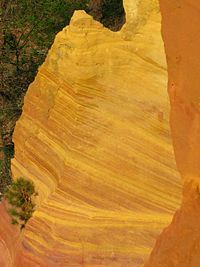
- Yellow ochre (also known as Mars yellow, Pigment yellow 42, 43),[38] hydrated ferric oxide (Fe
2O
3·H
2O), is a naturally occurring pigment found in clays in many parts of the world. It is non-toxic and has been used in painting since prehistoric times.[39] - Indian yellow is a transparent, fluorescent pigment used in oil paintings and watercolors. Originally magnesium euxanthate, it was claimed to have been produced from the urine of Indian cows fed only on mango leaves.[40] It has now been replaced by synthetic Indian yellow hue.
- Naples Yellow (lead antimonate yellow) is one of the oldest synthetic pigments, derived from the mineral bindheimite and used extensively up to the 20th century.[41] It is toxic and nowadays is replaced in paint by a mixture of modern pigments.
- Cadmium Yellow (cadmium sulfide, CdS) has been used in artists' paints since the mid-19th century.[42] Because of its toxicity, it may nowadays be replaced by azo pigments.
- Chrome yellow (lead chromate, PbCrO
4), derived from the mineral crocoite, was used by artists in the earlier part of the 19th century, but has been largely replaced by other yellow pigments because of the toxicity of lead.[43] - Zinc yellow or zinc chromate is a synthetic pigment made in the 19th century, and used by the painter Georges Seurat in his pointillist paintings. He did not know that it was highly unstable, and would quickly turn brown.
- Titanium yellow (nickel antimony titanium yellow rutile, NiO·Sb
2O
5·20TiO
2) is created by adding small amounts of the oxides of nickel and antimony to titanium dioxide and heating. It is used to produce yellow paints with good white coverage and has the LBNL paint code "Y10".[44] - Gamboge is an orange-brown resin, derived from trees of the genus Garcinia, which becomes yellow when powdered.[45] It was used as a watercolor pigment in the far east from the 8th century – the name "gamboge" is derived from "Cambodia" – and has been used in Europe since the 17th century.[46]
- Orpiment, also called King's Yellow or Chinese Yellow is arsenic trisulfide (As
2S
3) and was used as a paint pigment until the 19th century when, because of its high toxicity and reaction with lead-based pigments, it was generally replaced by Cadmium Yellow.[47] - Azo dye-based pigment (a brightly colored transparent or semitransparent dye with a white pigment) is used as the colorant in most modern paints requiring either a highly saturated yellow or simplicity of color mixing. The most common is the monoazo arylide yellow family, first marketed as Hansa Yellow.
Dyes
- Curcuma longa, also known as turmeric, is a plant grown in India and Southeast Asia which serves as a dye for clothing, especially monks' robes; as a spice for curry and other dishes; and as a popular medicine. It is also used as a food coloring for mustard and other products.[48]
- Saffron, like turmeric, is one of the rare dyes that is also a spice and food colorant. It is made from the dried red stigma of the crocus sativus flower. It must be picked by hand and it takes 150 flowers to obtain a single gram of stigma, so it is extremely expensive. It probably originated in the Mediterranean or Southwest Asia, and its use was detailed in a 7th-century BC Assyrian botanical reference compiled under Ashurbanipal.[49] It was known in India at the time of the Buddha, and after his death his followers decreed that monks should wear robes the color of saffron. Saffron was used to dye the robes of the senior Buddhist monks, while ordinary monks wore robes dyed with Gamboge or Curcuma longa, also known as Turmeric.
The color of saffron comes from crocin, a red variety of carotenoid natural pigment. The color of the dyed fabric varies from deep red to orange to yellow, depending upon the type of saffron and the process. Most saffron today comes from Iran, but it is also grown commercially in Spain, Italy and Kashmir in India, and as a boutique crop in New Zealand, the United Kingdom, France, Switzerland and other countries. In the United States, it has been cultivated by the Pennsylvania Dutch community since the early 18th century. Because of the high price of saffron, other similar dyes and spices are often sold under the name saffron; for instance, what is called Indian saffron is often really turmeric.
- Reseda luteola, also known as dyers weed, yellow weed or weld, has been used as a yellow dye from neolithic times. It grew wild along the roads and walls of Europe, and was introduced into North America, where it grows as a weed. It was used as both as a yellow dye, whose color was deep and lasting, and to dye fabric green, first by dyeing it blue with indigo, then dyeing it with reseda luteola to turn it a rich, solid and lasting green. It was the most common yellow dye in Europe from the Middle Ages until the 18th century, when it was replaced first by the bark of the quercitron tree from North America, then by synthetic dyes. It was also widely used in North Africa and in the Ottoman Empire.[50]
- Gamboge is a deep saffron to mustard yellow pigment and dye.[51] In Asia, it is frequently used to dye Buddhist monks' robes.[52][53] Gamboge is most often extracted by tapping resin from various species of evergreen trees of the family Guttiferae, which grow in Cambodia, Thailand, and elsewhere in Southeast Asia.[54] "Kambuj" (Sanskrit: कंबुज) is the ancient Sanskrit name for Cambodia.
-
Orpiment was a source of yellow pigment from ancient Egypt through the 19th century, though it is highly toxic.
-
Indian yellow pigment
-
Chrome yellow was discovered in 1809.
Zdroj:https://en.wikipedia.org?pojem=Yellow
Text je dostupný za podmienok Creative Commons Attribution/Share-Alike License 3.0 Unported; prípadne za ďalších podmienok. Podrobnejšie informácie nájdete na stránke Podmienky použitia.
Antropológia
Aplikované vedy
Bibliometria
Dejiny vedy
Encyklopédie
Filozofia vedy
Forenzné vedy
Humanitné vedy
Knižničná veda
Kryogenika
Kryptológia
Kulturológia
Literárna veda
Medzidisciplinárne oblasti
Metódy kvantitatívnej analýzy
Metavedy
Metodika
Text je dostupný za podmienok Creative
Commons Attribution/Share-Alike License 3.0 Unported; prípadne za ďalších
podmienok.
Podrobnejšie informácie nájdete na stránke Podmienky
použitia.
www.astronomia.sk | www.biologia.sk | www.botanika.sk | www.dejiny.sk | www.economy.sk | www.elektrotechnika.sk | www.estetika.sk | www.farmakologia.sk | www.filozofia.sk | Fyzika | www.futurologia.sk | www.genetika.sk | www.chemia.sk | www.lingvistika.sk | www.politologia.sk | www.psychologia.sk | www.sexuologia.sk | www.sociologia.sk | www.veda.sk I www.zoologia.sk











